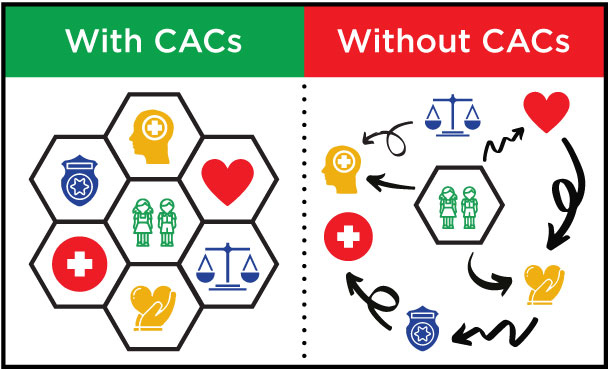About the CACs
Through investigative, preventative, and treatment services, Children’s Advocacy Centers (CAC) protect and care for victims of child abuse, neglect, human trafficking, and children who witness violent crimes.
What Do CAC's Do?
Children's Advocacy Centers coordinate the investigation, treatment, and prosecution of child abuse cases by utilizing multidisciplinary teams of professionals involved in child protective and victim advocacy services, law enforcement and prosecution, and physical and mental health.

Essential Functions of a CAC
Children's Advocacy Centers must include the following components:
- Child-appropriate facility.
- Multidisciplinary team.
- Designated legal entity responsible for program and fiscal operations.
- Culturally competent policies and practices.
- Forensic interviews conducted in an objective, nonduplicative manner.
- Medical evaluation and treatment.
- Therapeutic intervention.
- Victim support/advocacy.
- Case review and tracking.
MDT Model
The Multidisciplinary Team concept was a core aspect of the original Child Advocacy Center model developed by Bud Cramer during the early 1980’s. This innovative model recognized that in order for the United States to effectively respond to this issue that a unique public-private partnership was essential, and that the various agencies and departments responsible for the protection of children must be united in a collaborative effort to respond with the recognition that no one agency by itself could assure the protection of children.
Multidisciplinary team members include: law enforcement, child protection, prosecution, victim advocacy, medical and mental health professionals. The MDT members usually sign on to a Memorandum of Understanding (MOU) or Interagency that represents the shared commitment to the mission, purpose and intent of the CAC and the MDT approach for child abuse cases in our community.
Forensic Interview
A forensic interview is a fact-finding conversation conducted by a specially-trained Forensic Interviewer. The interview is designed to provide the child an opportunity to talk about the reason for their visit to the CAC. The Forensic Interviewer strives to make the child feel as comfortable as possible while gathering information to determine what may have occurred. Questions are asked in a non-leading manner at a pace that is comfortable for the child.
